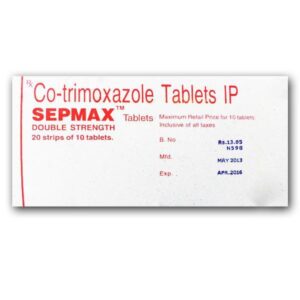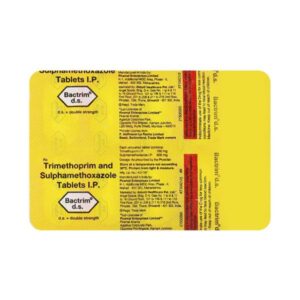TRIMETHOPRIM + SULPHAMETHOXAZOLE
Trimethoprim: Trimethoprim is an antibiotic drug commonly used to treat bacterial infections. It is a synthetic substance that inhibits the growth of bacteria by interfering with their ability to produce essential components needed for their survival.
Trimethoprim works by blocking an enzyme called dihydrofolate reductase, which is involved in the synthesis of DNA, RNA, and proteins in bacteria. By inhibiting this enzyme, trimethoprim effectively stops the bacteria from multiplying and spreading, allowing the body’s immune system to eliminate the infection.
This antibiotic is primarily used to treat infections of the urinary tract, such as bladder infections, and respiratory tract infections, such as bronchitis and pneumonia. It may also be prescribed to prevent or treat other types of bacterial infections, depending on the specific circumstances.
The usual dose of trimethoprim for adults is 100 mg to 200 mg twice a day, with the treatment duration varying depending on the severity and type of infection. Children may require a lower dose based on their age and weight.
While trimethoprim is generally well-tolerated, it may cause some side effects. Common side effects include nausea, vomiting, diarrhea, and loss of appetite. Less common side effects may include headache, dizziness, skin rash, and an allergy-like reaction. Rarely, trimethoprim may cause serious side effects such as a severe or life-threatening allergic reaction, blood disorders, or liver damage. It is important to seek medical assistance if any unusual or severe side effects occur.
Trimethoprim should be used with caution in individuals with kidney or liver problems, as the drug is eliminated from the body primarily through these organs. Additionally, it may interact with certain medications, such as blood thinners or antidiabetic drugs, so it is crucial to inform your healthcare provider about all current medications before starting trimethoprim treatment.
Overall, trimethoprim is a widely used antibiotic that effectively treats various bacterial infections. It is essential to follow the prescribed dosage and complete the full course of treatment to ensure the infection is fully eradicated and reduce the risk of antibiotic resistance.
Sulphamethoxazole: Sulphamethoxazole is an antibiotic medication that belongs to the class of drugs called sulfonamides. It is commonly prescribed for the treatment of bacterial infections, including urinary tract infections, respiratory tract infections, ear infections, bronchitis, and certain types of pneumonia.
The mechanism of action of sulphamethoxazole involves inhibiting the production of folic acid in bacteria, which is essential for bacterial growth and replication. By blocking the synthesis of folic acid, sulphamethoxazole effectively stops the bacteria from multiplying, leading to their eventual death.
The dosage of sulphamethoxazole can vary depending on the severity of the infection and the patient’s age and weight. Typically, for adults, the usual dose is 800 mg of sulphamethoxazole combined with 160 mg of trimethoprim (another antibiotic) taken twice a day. For children, the dosage is adjusted based on their body weight.
Like any medication, sulphamethoxazole can have side effects. Common side effects may include nausea, vomiting, diarrhea, loss of appetite, headache, and dizziness. Some individuals may experience more serious side effects, such as severe allergic reactions, skin rashes, liver problems, or blood disorders. It is important to seek medical attention if any unusual or severe side effects occur.
It is worth noting that sulphamethoxazole may interact with other medications, such as blood thinners, certain diuretics, and phenytoin (an anticonvulsant). Therefore, it is essential to inform your healthcare provider about all other medications you are taking to avoid potential drug interactions.
It is important to complete the full course of sulphamethoxazole as prescribed by your healthcare provider, even if you start feeling better before the medication is finished. This is important to ensure the complete eradication of the bacteria and prevent the development of antibiotic resistance.


